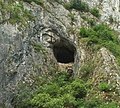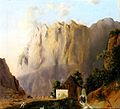

Turda Gorge (Romanian: Cheile Turzii, Hungarian: Tordai-hasadék) is a natural reserve (on Hășdate River) situated 6 km west of Turda and about 15 km south-east of Cluj-Napoca, in Transylvania, Romania.
Geography
The canyon, formed through the erosion of the Jurassic limestone of the mountain, is 2 900 m long and the walls have heights reaching 300 m. The total surface of the canyon is of 324 ha.
Cheile Turzii contain one of the richest and most scenic karst landscapes in Romania. More than 1000 plant and animal species (some of them rare or endangered, like the wild garlic or some species of eagle) live here.
History
The site has been inhabited since the neolithic.
Flora
More than 1,000 plant species can be found in the reservation, including Allium obliquum, Dianthus integripetalus, Viola jobi.
Fauna
67 species of birds, butterflies (Eublema, Heterogynis, Dysauxes, Phybalopterix etc.) fish, amphibians and some mammals (foxes, weasels, martens, wild boars etc.
Caves
There are some 60 known caves, almost all of them being of small size (the longest one is 120 m).
Other tourist attractions
Cheile Turzii are just a few km away from two other canyons (Cheile Turului and Cheile Borzești) as well as from Ciucaș waterfall.
Cheile Turzii is one of the main rock climbing sites in Romania.
Picture gallery
-
Turda Gorges seen from the west end
-
 Cheile Turzii
Cheile Turzii
-
One of the bridges of Cheile Turzii
-

-
 "Balica's Cave" in Cheile Turzii
"Balica's Cave" in Cheile Turzii
-
 The chalet
The chalet
-
Cheile Turzii seen from Turda
-
 Henric Trenk's painting of Cheile Turzii
Henric Trenk's painting of Cheile Turzii
See also
Notes
Further reading
- Turda, date istorice, Violeta Nicula, Editura Triade, pag. 64-66
External links
| Protected areas of Romania | ||
|---|---|---|
| Biosphere reserves |  | |
| National parks | ||
| Nature parks | ||
| Nature reserves | ||
46°33′50″N 23°40′45″E / 46.56389°N 23.67917°E / 46.56389; 23.67917
Categories: